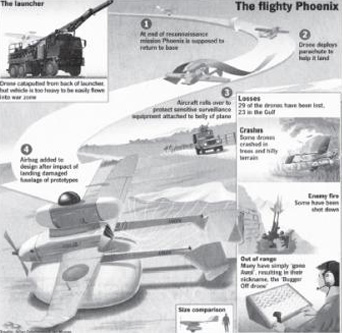1.2 The Phoenix project
It is all too easy to dismiss problems like that being experienced with the tax credit system as being inherent in the design and implementation of computer-based systems. But they are not restricted to computer systems, as the example of the Phoenix project in Box 2 shows.
Box 2 Fly-away drones put robot air force off course

The dismal failure of a British built drone during the war in Iraq has led the Ministry of Defence to reconsider its plans for a futuristic fleet of unmanned aircraft. Britain lost 23 of its Phoenix surveillance planes, which each cost about £1.5m.
Military tacticians believe drones will play an increasingly important role in 21st century conflicts. In Afghanistan drones were used to find and attack Al-Qaeda targets. An armed US Predator was also used in Yemen to assassinate a senior Al-Qaeda fugitive.
But there is growing controversy over Britain's preferred choices for an £800m drone air force. The Phoenix has such an abysmal record that the army, which uses it for artillery spotting, has called it ‘the Bugger Off’ because of its tendency never to come back.
Since 1996 198 drones have been delivered to the armed forces, but many have been cannibalised for spare parts, some have been mothballed and a large proportion of the working fleet was lost because the planes crashed, were shot down or just went missing in Iraq.
Britain is not buying any more Phoenixes, but despite the proven success of the American-built Predator the defence ministry decided earlier this year that it would buy either an Israeli-designed drone or a US unmanned reconnaissance helicopter. Both would need substantial modification if they were to carry weapons.
The Phoenix – named after a mythical bird that rises from the ashes, rather than one that crashes and burns – caused problems from the start. Development began in 1982 and it took 16 years before the plane entered service.
It has to land on its back because sensitive surveillance equipment was mounted on its underside. During trials it landed too heavily, damaging the fuselage.
Exasperated engineers fitted an airbag, similar to those found in cars, to cushion the impact. The development programme alone cost £250m.
Another problem is that the Phoenix is launched by catapult from a vehicle that is so heavy it cannot usually be flown into a battle theatre and has to be sent out from Britain by sea.
By contrast, American forces lost only four Predators during the war in Iraq. Two were deliberately wasted by being flown over Baghdad to draw fire until they ran out of fuel. One was shot down over the Tigris and Iraqi television showed pictures of soldiers and militia searching the riverbank for the pilot of what they thought was a manned warplane.
The Phoenix fiasco has led some senior military personnel to urge Geoff Hoon, the defence secretary, to think again and buy an off-the-shelf design with a proven record.
Air Commodore Ron Cook, who was last month appointed director of equipment capability for intelligence, surveillance, target acquisition and reconnaissance, has told colleagues that he is unhappy with the present choices and would like them to be reconsidered.
The two shortlisted designs are the Fire Scout helicopter and the Silver Arrow. The Fire Scout was built for the US Navy and Marine Corps, but only in small numbers because of concerns about its vulnerability. It is slower than fixed-wing designs and can be easier to shoot down.
The Silver Arrow is built by Elbit Systems of Israel for the Israeli military. It is being offered to Britain by the French arms contractor Thales.
Critics say the Ministry of Defence is accident-prone when it buys equipment. Hoon has inherited and presided over what insiders describe as a ‘zoo’ of turkeys, white elephants and dodos. Other fiascos include the new Apache attack helicopter. Some of the 67 aircraft ordered, which cost £27m each, are sitting in hangars because of a software problem on training simulators which means there are too few pilots trained to fly them.
Even the SA80, the army's standard issue rifle, caused years of problems. It performed well in Iraq but when it first entered service in 1986 soldiers said it often jammed and it had to be modified several times at a cost of £90m.
Software and software-focused systems of the sort highlighted in Box 1 seem to create severe difficulties when it comes to delivering what is required, when it is required and at the estimated cost. As Brooks (1987) put it:
Of all the monsters that fill the nightmares of our folklore, none terrify more than werewolves, because they transform unexpectedly from the familiar into horrors. For these, one seeks bullets of silver that can magically lay them to rest.
The familiar software project, at least as seen by the non-technical manager, has something of this character; it is usually innocent and straightforward, but is capable of becoming a monster of missed schedules, blown budgets, and flawed products. So we hear desperate cries for a silver bullet – something to make software costs drop as rapidly as computer hardware costs do.
But, as we look to the horizon of a decade hence, we see no silver bullet. There is no single development, in either technology or in management technique, that by itself promises even one order-of-magnitude improvement in productivity, in reliability, in simplicity.
It is nearly twenty years since these gloomy predictions were made, but the example reported in Box 1 suggests that we have still not found the silver bullet with which to lay the werewolves of software-focused systems developments to rest. Equally, the example in Box 2 of the Phoenix unmanned surveillance aircraft shows that failure is not confined to software projects.
The problems that lead to the partial or complete failure of a complex systems project can be grouped into three categories:
-
a misunderstanding or uncertainty about the ‘wants’ being addressed (see Example 1 below)
-
an inability to design a system that will meet a requirements set (Example 1)
-
an incomplete or poorly executed implementation (Example 2).
